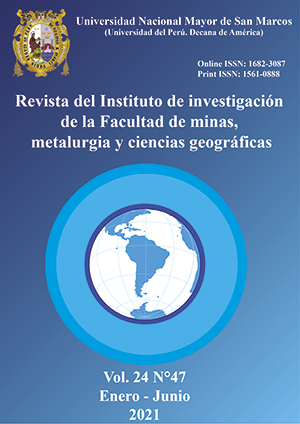Properties of Eichhornia crassipes (Jacinto de agua), Schoenoplectus colifornicus (Junco), and Phragmites australis (Carricillo)
DOI:
https://doi.org/10.15381/iigeo.v24i47.20656Keywords:
Eichhornia Crassipes (Jacinto de agua), Schoenoplectus Colifornicus (Junco), and Phragmites Australis (carricillo), as a heavy metal scrubberAbstract
This research work has served to determine the ability to remove heavy metals and find the appropriate plant, taking advantage of the benefits of the following species: Eichhornia crassipes (Water hyacinth, mouth flower or camalote), Schoenoplectus colifornicus (Junco or totora ), and Phragmites australis (Carricillo or climbing grass), for this, three duly waterproofed wooden ponds of the following dimensions were built: 0.30 meters wide x 0.40 meters high and 1.60 meters long, making a volume of 0.192 cubic meters, located next to a house in the town of Nueva Esperanza in the district of Santa María, Huaura province, Lima region. The three varieties of plants were planted in each pond and each one of them has entered residual water from the house, uninterruptedly and after more than 90 days of growth, the services of an accredited Bureau Veritas laboratory were hired to perform the analyzes respective. These results indicate that the three types of vegetables assimilate the chosen metals, the most efficient being Eichhornia Crassipes (water hyacinth), with 94.73% for Nickel, 84.36% for Lead, and 78.48% for cadmium, in the case of Schoenoplectus Colifornicus (Junco), for Nickel it was 83.00%, Lead 61.23% and Cadmium 51.90%, and for Phragmites Australis (carricillo), in the case of Nickel it was 79.90%, Lead 60.23% and Cadmium 29.11%, so Therefore, water hyacinth is recommended to capture heavy metals from domestic and / or industrial wastewater. While in the analysis table regarding the three types of vegetables, in the first case the result of the three types of vegetables that grow wild in the swamps near the area, forming large communities, while the second analysis corresponds to the three types of vegetables that have been planted in the ponds in which the domestic residual water of a house enters, precisely to notice the differences in terms of the content of heavy metals, the results being the following: 57.00% for the water hyacinth , 42.00% for the reed and 37.00% for the reed, with this it is shown that of the three types of vegetables studied, the water hyacinth is the most efficient, therefore it is recommended for capturing heavy metals from domestic wastewater.
Downloads
Published
Issue
Section
License
Copyright (c) 2021 Alejandro Mena Ayala

This work is licensed under a Creative Commons Attribution 4.0 International License.
AUTHORS RETAIN THEIR RIGHTS:
a. Authors retain their trade mark rights and patent, and also on any process or procedure described in the article.
b. Authors retain their right to share, copy, distribute, perform and publicly communicate their article (eg, to place their article in an institutional repository or publish it in a book), with an acknowledgment of its initial publication in the Rev. Inst. investig. Fac. minas metal cienc. geogr.
c. Authors retain theirs right to make a subsequent publication of their work, to use the article or any part thereof (eg a compilation of his papers, lecture notes, thesis, or a book), always indicating the source of publication (the originator of the work, journal, volume, number and date).






